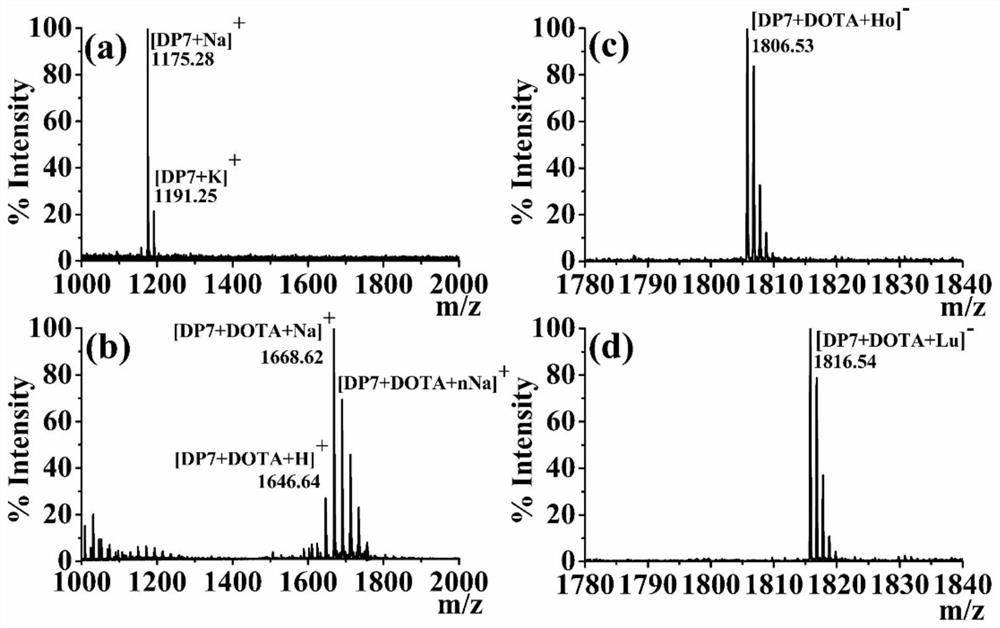A method for the relative quantification of n-glycan chains based on mass spectrometry
A relatively quantitative, sugar chain technology, applied in the field of biochemical analysis, can solve the problems of low abundance, microscopic inhomogeneity, low ionization efficiency, etc., and achieve the effect of improving fragmentation, improving ionization efficiency, and high derivatization efficiency.
- Summary
- Abstract
- Description
- Claims
- Application Information
AI Technical Summary
Problems solved by technology
Method used
Image
Examples
Embodiment 1
[0032] Embodiment 1 Reductive amination and the investigation experiment of metal chelation reaction derivation efficiency
[0033] 100 μg of DP7 (10 μg / μL) was mixed with 232 μg of aniline-functionalized DOTA (5.8 μg / μL) and lyophilized, dissolved in 40 μL of methanol solution (acetic acid / methanol: v / v 15:85), at 37°C After 1 hour of reaction, the reducing agent sodium cyanoborohydride (acetic acid / methanol: v / v 15:85) was added so that the final concentration was 5 mg / mL, and the total system was 50 μL, and the reaction was continued at 37°C for 2 hours. MALDI mass spectrometry was performed on the DP7 before the reaction and the DP7 after the reaction. DP7 was almost completely converted into DOTA-Lu-labeled DP7, and it was almost invisible before underrivatization. The results were as follows image 3 (a) and 3(b);
[0034] After lyophilizing 75 μL of the DOTA-derivatized DP, add 20 μL of HoCl 3 (4.82μg / μL, 10mM NH 4 AC,pH5.6) or LuCl 3 (5.00μg / μL, 10mM NH 4 AC, pH 5...
Embodiment 2
[0035] Example 2 Investigation of the ability of aniline-functionalized DOTA-labeled sugar chains to rechelate rare earth metal ions to improve the sugar chain signal
[0036] 100 μg of DP7 (10 μg / μL) was mixed with 232 μg of aniline-functionalized DOTA (5.8 μg / μL) and lyophilized, dissolved in 40 μL of methanol solution (acetic acid / methanol: v / v 15:85), at 37°C After reacting for 1 hour, add the reducing agent sodium cyanoborohydride (acetic acid / methanol: v / v 15:85) to make the final concentration 5 mg / mL, and the total system is 50 μL. After continuing to react for 2 hours at 37 ° C, take out 5 μL frozen After drying, add 20 μL of LuCl 3 (5.00μg / μL, 10mM NH 4 AC, pH 5.6), react at 37°C for 1 hour, add 10 μg of DP7 and mix well, take out 1 μL and dilute 10 times with ultrapure water for MALDI mass spectrometry analysis, the results are as follows Figure 4 (a) and 4(b).
Embodiment 3
[0037] Example 3 Investigating the accuracy and repeatability of DOTA-labeled sugar chain rechelation of rare earth metal ions relative quantitative method
[0038] According to the method of Example 1, after derivatizing DP7 with DOTA-Lu and DOTA-Ho respectively, take equimolar DOTA-Lu-labeled DP7 and DOTA-Ho-labeled DP7 and mix them for MALDI mass spectrometry analysis. The results are as follows Figure 5 As shown in (a); the signal intensity of DOTA-Lu-labeled DP7 is close to the theoretical ratio of DOTA-Ho-labeled DP7 signal intensity, and different molar ratios (1:10,1:5,1:2,1:1,2: 1,5:1,10:1) DOTA-Lu-labeled DP7 and DOTA-Ho-labeled DP7 were mixed, analyzed by MALDI mass spectrometry, and the intensity ratio obtained from the experiment was compared to the theoretical graph to obtain Figure 5 (b), the results show that the method of the present invention has good quantitative accuracy (R=0.9995), the experiment was repeated three times, and the coefficient of variation...
PUM
 Login to View More
Login to View More Abstract
Description
Claims
Application Information
 Login to View More
Login to View More - R&D
- Intellectual Property
- Life Sciences
- Materials
- Tech Scout
- Unparalleled Data Quality
- Higher Quality Content
- 60% Fewer Hallucinations
Browse by: Latest US Patents, China's latest patents, Technical Efficacy Thesaurus, Application Domain, Technology Topic, Popular Technical Reports.
© 2025 PatSnap. All rights reserved.Legal|Privacy policy|Modern Slavery Act Transparency Statement|Sitemap|About US| Contact US: help@patsnap.com



